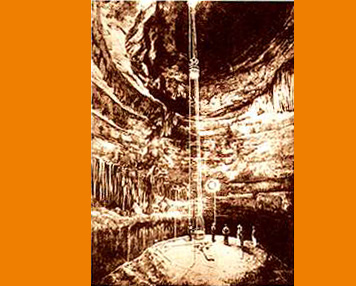The "publicity" took over and ensured the promotion of the chasm in detailed articles:
"We are happy to learn that the Gouffre de Proumeyssac is receiving more and more visitors. Thanks to the new system established by the owners, tourists from all over the world can descend safely to visit this immense abyss which is admired by all (...). Visitors descend in an elevator and there is room for four people in the basket. After crossing a thick layer of rocks, the elevator arrives in the middle of an immense acetylene-lit cathedral. The dome is majestic and sparkling white stalactites and stalagmites shine from all sides. It is an almost sepulchral residence where the silence is only disturbed by the monotonous sound of the small waterfalls whose crystal-like water disappears into other even deeper chasms. Nature seems to have spared no efforts here and anything we can say about this place is well beyond reality. You have to see it to get an accurate picture". (These statements still apply today!).
The cave, which extended under the properties of Messrs Francès and Soulié, and operating equipment, represented their contribution to the civil society established between Messrs Galou, Francès and Soulié, by a deed executed before Mr Castinel, a notary of Le Bugue, on 21 May 1907.
A sale by auction of the right to exploit the cave until 21 May 1957 was put out to tender by public auction, in the study of Mr Castinel on 20 February 1910. With its new structure, the operating company increased the number of daily visits, interrupted only by the First World War. But it was only after 1924 that the underground tourism of Proumeyssac really took off. In a leaflet published in 1925, included in a package of postcards, Jean Vézère, a Buguois poet, recounts the visits.
"Thanks to the work and sacrifices of Messrs Soulié and Francès, the descent into the cave no longer poses a danger, and this once perilous exploration has become a pleasure. The opening can be reached directly by carriage and motor car. A securely and well-conditioned winch is used to descend visitors safely and conveniently into the abyss. Electricity has replaced the early makeshift lighting, shedding streams of milky light on the walls of the chasm, where our fathers once saw hell's mouth.
During the summer, Proumeyssac receives thousands and thousands of visitors. Three by three, the tourists board the cage that is slowly lowered down a dark and narrow shaft. Soon, the only thing one sees overhead is a small circle of sky. Then, about ten feet below the hole, the walls suddenly widen; a light illuminates a great underground cavern where countless stalactites, shaped like chandeliers, candles and columns, resemble the most prestigious decorations of a magnificent cathedral, a fairy-tale palace, sculpted in marble, carved out of alabaster or crystal. The cage reaches the bottom (50 metres), and the tourists follow the guide through the naturally hollowed out passages and galleries of bright white calcite".
A pleasure? No doubt, but certainly filled with many scares and shivers because the cage was powered by a horse-operated winch. Some even say a donkey, others a mule! Regardless: it was a real adventure; and at any rate you can easily imagine the jolts and stops (!) in mid-drop, on account of the animal's temperaments or immediate concerns. All of which was immediately reflected in the cries of the passengers in the cage. Given that the electrical installation was also makeshift, the trip down frequently took place partly in the dark! Was it an unforgettable visit? Absolutely guaranteed!
A few years later, safety issues, then the war of 1939-1945, put an end to these epic tours. The cave sank into oblivion for a few years.
There was a revival of tourism in the post-war years. The tourist information office which was reconstituted under the chairmanship of the dynamic and dedicated Marcel Maufrangeas, decided to open Proumeyssac again. In 1949, a board of directors was formed, and in 1950, Mr. Chamine, an engineer and director of the Simeyrols brown coal mine, put forward a project requiring six million francs. The money was quickly collected and on 6 August 1950, the cave was reopened to the public during a memorable opening day. A comfortable elevator, consisting of two cabins with a capacity of six people each, replaced the old cage; a generator replaced the donkey and visitors flocked to the site. In less than one month 5,000 descents were made.
However, Proumeyssac was also visited on several occasions by the most famous speleologist and the press made sure to pass on his comments: "The Gouffre de Proumeyssac is the only one in France and, to the best of my knowledge, in Europe, where one can reach the bottom without going down a single step or taking an artificial access tunnel. Indeed, here visitors descend without tiring in an elevator that hangs boldly in the air, which suddenly emerges at the top of the nave-like cathedral vault. The tour is, for this reason, very original and impressive, as is the quite remarkable internal decoration of this splendid cavity. The Gouffre de Proumeyssac offers an abundance and variety of stalactites, stalagmites and very pure and translucent draperies, making it one of the most beautiful underground jewels of France." Alas! In 1952 everything was called into question. The cave was yet again closed for several years because the elevator "handing boldly in the air" was deemed dangerous by the Veritas agency. Additionally, there was a trial opposing the contractor who carried out the work and the Board of Directors. Pending the verdict, the contentious equipment was to remain in the cavity.
Totally discouraged, many would have given up. This was not the case of the determined Marcel Maufrangeas. In 1956, during a meeting attended by Robert de Joly - another famous caver and speleologist credited with several tourist developments of caves - he advised drilling a tunnel. This solution was adopted, and despite sceptics and critics, the work made good progress.


